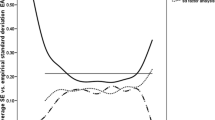Abstract
Although classical test theory (CTT) has defined the standard of questionnaire development for several decades, an increasing number of standardized tests are now developed using item response theory (IRT) as an alternative to CTT. Unlike CTT, the examinee’s true score is not test dependent, and the item parameters are not sample dependent, therefore the parallel test assumption is not necessary in IRT. IRT also includes indices to discern the strength and weakness of each item in a test. For example, we can distinguish good and bad items in terms of how much information an item provides about examinees’ trait levels. Further, IRT provides solutions for many practical testing problems such as equating different test forms and examining measurement bias. IRT models can be appropriately applied to many measures in behavioral medicine, such as measures of psychopathology, moods, behavioral dispositions, and situational evaluations. Therefore, application of IRT models and associated methods can solve many practical problems in behavioral medicine.
Access this chapter
Tax calculation will be finalised at checkout
Purchases are for personal use only
Similar content being viewed by others
References
Allen, M. J., and Yen, W. M. (1979). Introduction to Measurement Theory. Belmont, California: Wadsworth.
Andrich, D. (1978a). Application of a psychometric model to ordered categories which are scored with successive integers. Appl Psychol Meas, 2, 581–594.
Andrich, D. (1978b). A rating formulation for ordered response categories. Psychometrika, 43, 561–573.
Bock, R. D. (1972). Estimating item parameters and latent ability when responses are scored in two or more nominal categories. Psychometrika, 37, 29–51.
Birnbaum, A. (1968). Some latent trait models and their use in inferring an examinee’s ability. In F.M. Lord & M. R. Novick, Statistical Theories of Mental Test Scores (Chapters 17-20). Reading, MA: Addison-Wesley.
Dodd, B. G., De ayala, R. J., and Koch, W. R. (1995). Computerized adaptive testing with polytomous items. Appl Psychol Meas, 19, 5–22.
Embretson, S. E. (1996). Item response theory models and inferential bias in multiple group comparisons. Appl Psychol Meas, 20, 201–212.
Embretson, S. E., and Reise, S. P. (2000). Item Response Theory for Psychologists. Mahwah, NJ: Lawrence Erlbaum Associates.
Engelhard, G., and Wilson, M. (Eds). (1996). Objective Measurement III: Theory into Practice. Norwood, NJ: Ablex.
Hambleton, R. K., Swaminathan, H., and Rogers, H. J. (1991). Fundamentals of Item Response Theory. Newbury Park, CA: Sage Publications, Inc.
Lord, F. M. (1952). A Theory of Test Scores (Psychometric Monograph No. 7). Iowa City, IA: Psychometric Society.
Lord, F. N., and Novick, M. R. (1968). Statistical Theories of Mental Test Scores. Reading, MA: Addison-Wesley.
Masters, G. N. (1982). A Rasch model for partial credit scoring. Psychometrika, 47, 149–174.
Muraki, E. (1990). Fitting a polytomous item response model to Likert-type data. Appl Sychol Meas, 14, 59–71.
Muraki, E. (1992). A generalized partial credit model: application of an EM algorithm. Appl Psychol Meas, 16, 159–176.
Muraki, E., and Bock, R. D. (1997). PARSCALE 3: IRT Based Test Scoring and Item Analysis for Graded Items and Rating Scales. Chicago: Scientific Software International, Inc.
Rasch, G. (1960). Probablistic models for some intelligence and attainment tests. Chicago: University of Chicago Press.
Reise, S. P., and Waller, N. G. (1990). Fitting the two-parameter model to personality data: the parameterization of the Multidimensional Personality Questionnaire. Appl Psychol Meas, 14, 45–58.
Reckase, M. (1997). The past and future of multidimensional item response theory. Appl Psychol Meas, 21, 25–36.
Samejima, F. (1969). Estimation of Latent Ability Using a Response Pattern of Graded Scores. Iowa City, IA: Psychometric Society.
Santor, D. A., Ramsay, J. O., and Zuroff, D. C. (1994). Nonparametric item analyses of the Beck depression inventory: evaluating gender item bias and response option weights. Psychol Assess, 6, 255–270.
Spearman, C. (1904). The proof and measurement of association between two things. Am J Psychol, 15, 72–101.
Spearman, C. (1907). Demonstration of formulae for true measurement of correlation. Am J Psychol, 18, 161–169.
Spearman, C. (1913). Correlations of sums and differences. Br J Psychol, 5, 417–426.
Author information
Authors and Affiliations
Corresponding author
Editor information
Editors and Affiliations
Rights and permissions
Copyright information
© 2010 Springer Science+Business Media, LLC
About this chapter
Cite this chapter
Kim-O, MA., Embretson, S.E. (2010). Item Response Theory and Its Application to Measurement in Behavioral Medicine. In: Steptoe, A. (eds) Handbook of Behavioral Medicine. Springer, New York, NY. https://doi.org/10.1007/978-0-387-09488-5_9
Download citation
DOI: https://doi.org/10.1007/978-0-387-09488-5_9
Published:
Publisher Name: Springer, New York, NY
Print ISBN: 978-0-387-09487-8
Online ISBN: 978-0-387-09488-5
eBook Packages: Behavioral ScienceBehavioral Science and Psychology (R0)




